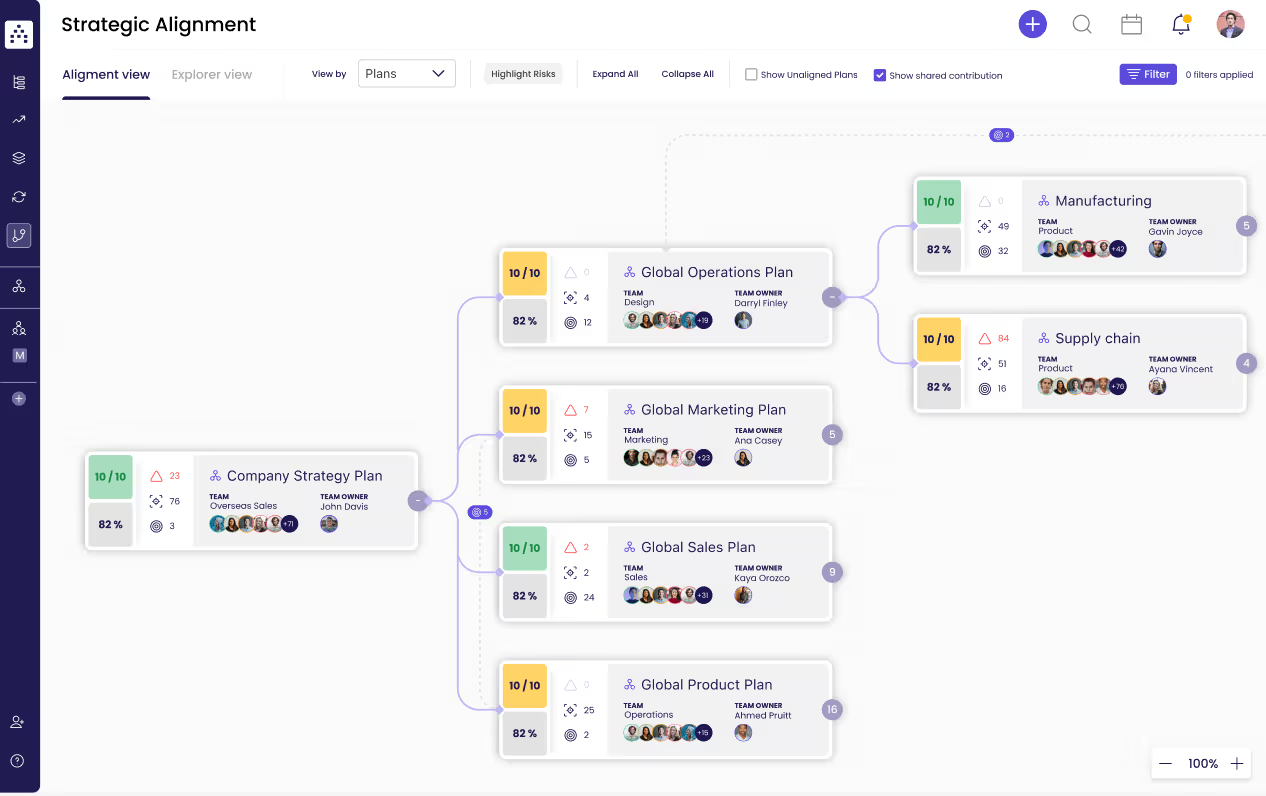Every business leader should be familiar with different levels of strategy. Strategy comes in various forms: the strategy for a multi-national company will differ from that of a startup.
Yet, the principles remain. To understand how strategies shift, we'll examine the existing strategy levels and how an organization can apply them.
The key takeaway from this article is that strategy is for everyone.
You don't have to wait until your business grows to a certain size to “get strategic.” Be aware of where you are as a business so you can develop a strategy that fits and grows with your organization.
In this article, we'll discuss how the strategy levels in an organization differ and provide context on how to use these different levels of strategy in strategic management.
We’ll also show you how you can centralize your strategy in Cascade and ensure the alignment between the different levels for successful and effective strategy execution!
The Levels Of Strategy
Strategists often refer to three levels of strategy: corporate level strategy, business level strategy, and functional level strategy.
But, they are missing a fundamental level that is key for successful strategy execution: operational level strategy.
This article outlines the basics of the four levels in strategic management, but if you're interested in delving deeper into a specific level, we also offer individual articles dedicated to each one:
.avif)
No matter the level of strategy, "organizations that promote transparency and a collective culture when it comes to strategy, generate a stronger commitment and sense of accountability from their employees." This statement by Guillermo Hermosillo Cue, Global Innovation Director at Burger King in our state of strategy report echoes the importance of strategic communication regardless of the strategy level.
Corporate Level Strategy
.avif)
The corporate strategy is the highest-level strategy in an organization. It defines the organization’s overall direction and the high-level ideas of how to move towards it.
These plans are usually created by leadership, such as the CEO and top management. Generally, this is the group involved because they have a deep understanding of the company and the strategic business knowledge needed to steer the organization in the right direction.
A corporate strategy is generally broader than the other strategy levels. Strategies at this level are more conceptual and futuristic than the other levels. They usually span a 3-5 year period.
A corporate strategic plan generally encompasses:
- The core business metrics
- The strategic focus areas
- The corporate goals
- The strategic objectives
- The most important KPIs
⚠️ Important! The corporate level strategy needs to take into account the foundational elements of the organization: its vision statement, mission statement, and company values.
Why create a corporate strategy?
In the corporate strategic plan, you're essentially mapping out where your organization should play.
This master plan sets the stage for developing business unit strategies and functional level strategies, along with nitty-gritty operational plans.
These strategies, in turn, will guide the downstream decisions made by employees of all levels. Therefore, every decision made in the organization should directly or indirectly contribute to the strategy's corporate objectives.
.avif)
Every organization needs a corporate strategy. There is no such thing as a too-small organization nor a too-large one to define what they want to achieve and how they will do it.
👉🏻 Grab your free corporate strategy template to follow a structured approach and create your corporate strategic plan.
Business Level Strategy
.avif)
The business level strategy is the second tier in the strategy hierarchy. Sitting under the corporate strategy, the business strategy is a means to achieve the goals of the specific business units in the organization.
The objectives and strategic initiatives within each business unit’s strategy will be focused on gaining a competitive advantage in the particular market in which the business unit operates.
There are different types of business level strategies organizations adopt depending on the competitive advantage they want to gain. Organizations face crucial decisions here, with options like adopting a growth strategy, differentiation strategy, or embracing a cost leadership approach.
📚 Learn more about the different types of business strategies in our article: What Is A Business Level Strategy? How To Create It + Examples
Each business area must make a strategic decision and define the approach they’ll choose to get closer to their goals.
Business strategy examples
A large bank is a prime example of an organization selling multiple services in different industries.
To name a few, it has business units like retail banking, investment management, and insurance company. Each of these business units has distinct goals and a distinct business unit strategy to achieve them.

📚 Read more: The 7 Best Business Strategy Examples I've Ever Seen
Include middle managers in the business strategy
Strategies at the business level should be constructed by VPs and—global or regional—business unit heads. However, also including other middle managers within each business unit is a best practice.
Including a range of managers from each unit to participate in the strategy process has two main benefits:
- It increases buy-in:
Managers who've had a chance to contribute to the strategy formulation feel included in the decision-making. Therefore, they’re more likely to accept the strategy and jump on board with its execution. - It improves ownership:
Employees who are given the opportunity to contribute to the strategy development are more likely to take ownership of its completion.
💡 Pro Tip: If your organization has multiple business units, this strategy level becomes crucial. However, if you only have one business unit, you don't need to worry about this level and can skip to the functional strategy level.
👉🏻 Grab your free business strategy template to follow a structured approach and create your business strategic plan.
Functional Level Strategy
.avif)
This level of strategy designs the approach for the different functional areas or departments—we’ve already given you a little spoiler with the previous image of the bank strategy levels example. These functions can include the marketing department, finance, supply chain, manufacturing, human resources, and more.
The primary objective of functional strategy is to align the activities and efforts of these individual departments with the broader goals and strategic objectives set at higher levels, such as corporate and business strategy.
Functional strategies have a fairly narrow focus. They are designed to address the unique challenges and opportunities within each functional area.
Your finance strategy, marketing strategy, human resource strategy, etc., all have goals and responsibilities to deliver. Having a visible functional level of strategy that aligns with the overarching corporate strategy will increase the chances of success.
These strategies involve resource allocation, measurable goals, and a focus on continuous improvement, all within the context of individual functions.
The secret to a successful functional strategy
Having each department equipped with a well-defined functional strategy is an excellent beginning. But beware of the pitfalls of isolating each functional area in its own strategy bubble; that's venturing into siloed territory.
There are two pivotal aspects to keep in mind for a successful functional strategy:
- Cross-functional collaboration: The magic happens when different departments join forces. Fostering collaboration between these functions opens the door to innovation and synergy.
- Strategic alignment: Ensuring that the strategy of each functional area seamlessly matches the overall corporate strategy goals is the foundation of success.
In Cascade, you can create strategic plans for each function in your organization, which link back to the main corporate plan to ensure everything is moving in the right direction.
"A journey of a thousand miles begins with one step,” as the saying goes.
Check out strategic planning templates for different functions:
- Marketing Strategy Template
- HR Strategy Template
- Financial Strategy Template
- Supply Chain Strategy Template
📚 Explore thousands of other free strategy templates in our Template Library!
Companies usually stop at the first three levels of strategy, but the fourth level is the most important one to ensure successful execution. These three levels of strategy—corporate, business, and functional—set the foundation, but it's the operational strategy that brings all the plans to life on the ground.
Operational Level Strategy
.avif)
Operational level strategy, situated at the lowest tier of the strategic hierarchy, focuses on the day-to-day actions and tactics needed to run the business, manage processes, and implement change effectively. It’s the “boots-on-the-ground” aspect of strategy, ensuring that plans are translated into tangible actions and results.
In simple terms, this is the strategy that will inform the day-to-day work of employees and will ultimately keep your organization moving in the right direction.
It's primarily concerned with short-term objectives and the practical execution of plans, detailing the specific actions, procedures, and activities that need to be executed to meet organizational goals.
The operational strategy involves roles like PMOs, team leaders, individual contributors, and team members, and plays a pivotal role in the successful implementation of broader strategies.
Cascade Strategy Execution Platform improves operational efficiency by eliminating duplication and aligning teams toward common goals. It helps reduce waste caused by misalignment, promoting streamlined operations and optimal performance.
Key characteristics of operational strategy
- Tactical Execution: Operational strategies focus on executing tactical steps to achieve business objectives, offering a detailed roadmap for execution.
- Short-Term Focus: Geared towards short-term goals and might encompass quarterly, monthly, or even daily activities.
- Resource Utilization: Deals with resource allocation at a detailed level, including workforce management, budget allocation, and technology deployment for specific projects and initiatives.
- Project Management: Operational strategies often include project management to coordinate teams and meet time and budget constraints.
- Feedback and Adaptation: They incorporate feedback loops, allowing adjustments as circumstances change.
- Immediate Impact: Success at the operational level directly contributes to achieving broader business and corporate goals, serving as a linchpin in strategy execution.

Differences Across The Four Strategy Levels
Understanding the differences helps ensure that each strategy level is tailored to its unique role within the organization.
Decision-making timeframes
Corporate-level strategy involves decisions that span several years to decades, defining the organization's overall direction and long-term vision. In contrast, business-level strategy concentrates on 3-5 year plans, dealing with the competitive position in specific markets or industries. Functional-level strategy targets optimizing department functions like marketing, HR, or finance within annual cycles, while operational-level strategy addresses day-to-day decisions to implement higher-level strategies.
Scope of influence
The entire organization is influenced by corporate-level strategy, which sets broad strategic objectives affecting all business units and functions. On the other hand, business-level strategy focuses and zeroes in on individual units to create competitive advantage in the market. Aligning departmental activities with business and corporate goals is the main focus of functional-level strategy. Operational-level strategy, however, details steps for teams and individuals to achieve functional objectives and ensure smooth operations.
Focus areas
Growth, mergers and acquisitions, diversification, and portfolio management are central to corporate level strategies. Competitive strategy, market segmentation, and value proposition for a specific target market or product take precedence in each business unit strategy. Functional-level strategy aims to optimize department-specific activities and resources to support business unit goals. Finally, operational-level strategy emphasizes executing tasks, managing projects, and meeting immediate objectives to support functional goals.
.avif)
Strategy Levels Aligned: The Key To Effective Execution
Understanding the levels of strategy is a big part of getting the creation right. However, with increased levels, there can be increased confusion.
Our dedicated strategy execution platform, Cascade, allows you to centralize your strategy into one central hub. It empowers you to build your strategic plans and visualize how they work together. Easily see how your corporate strategy breaks down into business, functional, and operational plans, all in one cohesive platform.

Cascade simplifies the alignment of projects and encourages collaboration across plans and departments, making strategic execution a breeze.
Sign up to Cascade for FREE or book a demo with one of our strategy experts to learn how you can plan, execute, and track your strategy in one easy-to-use platform.

%20(1).avif)

.avif)


.png)
.jpg)
.jpg)
%20(1)%20(1)%20(1)%20(1)%20(1).png)



